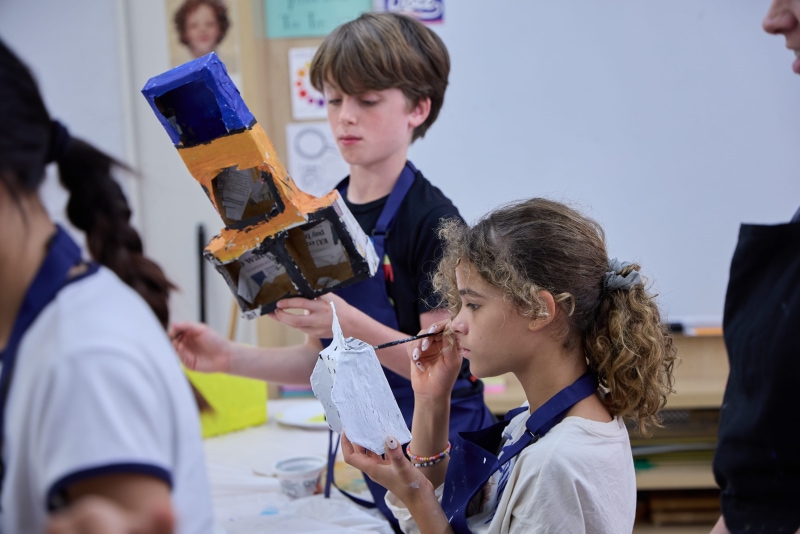Visual Arts
Visual arts fosters spatial awareness, fine motor skills, a sense of aesthetics, and so much more. A wide variety of artistic approaches and media help students realize their potential. SFS students focus on process over product while still keeping an eye toward the importance of completing and refining work. Projects are frequently interdisciplinary and infused with problem-solving skills alongside artistic techniques.
Preschool
The foundation for artistic exploration begins through play and sensory experiences in the classroom. Children engage in activities that enhance fine motor skills and explore various materials and textures. Activities emphasize process over product, encouraging children to express themselves freely and experiment without constraints. Through these early experiences, they begin to develop spatial awareness, color recognition, and a basic understanding of artistic tools and materials, laying the groundwork for more structured activities in kindergarten art classes.

Kindergarten
Students delve into fundamental art concepts, starting with color mixing, using primary colors to create secondary hues. They learn clay techniques like pinch pots, exploring slip and score methods. Students study art elements such as line, shape, color, and texture, while grasping size relationships like "big to small" and how shapes interact. Projects include crafting coil pots, making African guinea fowl, designing color wheels, and creating fish prints using complementary colors.

1st Grade
Creative expression is encouraged as students expand on color mixing and explore warm and cool color studies. Building on size concepts, students learn shape relationships. They are introduced to sewing, creating patterns and recognizing existing ones. Projects involve making stuffed animals, creating abstract art, fashioning found object creatures, and sculpting clay dinosaurs.

2nd Grade
Technical skill development blends with creative applications as students deepen color mixing skills with primary and secondary colors, alongside continuing concepts of size and shape relationships. Weaving is introduced with an emphasis on the over-under structure, and the study of art elements like line, shape, color, and texture is furthered. Compositional skills are developed, and projects include watercolor bird paintings, circular weavings, and clay tea cups with saucers.

3rd Grade
Students deepen their understanding of color and value while promoting observational and sculptural skills. They focus on color studies, specifically tints and shades, while reinforcing size and shape relationships. Weaving skills are advanced through understanding the over-under structure and scale concepts. Grayscale value studies are introduced, assigning value regardless of color. Projects include negative/positive trees, botanical drawings, and clay self-portraits.

4th Grade
Color theory, clay techniques, and perspective drawing are explored. Students explore monochromatic and analogous color schemes, further develop weaving skills with the over-under structure, and learn roll and cut clay slab techniques. Value representation for form is taught through grayscale, emphasizing value assignment regardless of color. Projects include self-portraits using value, clay looms woven with analogous yarn, and perspective chalk drawings.

5th Grade
Students develop concrete thinking and small motor skills through diverse media. They engage in 2D and 3D expressions of the same themes, exploring drawing, painting, printing, ceramics, mixed media, and sculpture. Design thinking skills are developed, and artworks reflect community and cultural traditions. Projects include opening painting projects, cross curricular units, self-portraits, clay painting palette prototyping, Día de los Muertos artwork, Etel Adnan-inspired felt landscapes, Beatriz Milhaze-inspired collage art, and interdisciplinary refugee art units.

6th Grade
Students experiment and increase their cultural awareness while utilizing multi-tiered, student-centered art units, covering drawing, painting, printing, ceramics, and mixed media. Design thinking skills are emphasized, with a focus on skill and technique. Projects include opening painting projects, Día de los Muertos collaborations, clay vessel design variations, timed figure drawing, interdisciplinary units, and contemporary artist studies.

7th Grade
Creative risk taking, critical thinking, and group collaboration are encouraged in 7th grade. Students focus on abstract thinking skills and applying sustained effort to longer-term projects. They engage in drawing, painting, printing, and mixed media, along with visual storytelling and personal expression. Work reflects community and cultural traditions. Projects include interdisciplinary units and contemporary artist studies.

8th Grade
Eighth grade builds upon the seventh grade's approach with multi-tiered, student-centered units and diverse mediums like drawing, painting, and printmaking. Design thinking skills are integral, and students create works reflecting community and cultural traditions while exploring creative processes. Projects feature opening painting projects, interdisciplinary units, and contemporary artist studies.

Preschool
The foundation for artistic exploration begins through play and sensory experiences in the classroom. Children engage in activities that enhance fine motor skills and explore various materials and textures. Activities emphasize process over product, encouraging children to express themselves freely and experiment without constraints. Through these early experiences, they begin to develop spatial awareness, color recognition, and a basic understanding of artistic tools and materials, laying the groundwork for more structured activities in kindergarten art classes.

Kindergarten
Students delve into fundamental art concepts, starting with color mixing, using primary colors to create secondary hues. They learn clay techniques like pinch pots, exploring slip and score methods. Students study art elements such as line, shape, color, and texture, while grasping size relationships like "big to small" and how shapes interact. Projects include crafting coil pots, making African guinea fowl, designing color wheels, and creating fish prints using complementary colors.

1st Grade
Creative expression is encouraged as students expand on color mixing and explore warm and cool color studies. Building on size concepts, students learn shape relationships. They are introduced to sewing, creating patterns and recognizing existing ones. Projects involve making stuffed animals, creating abstract art, fashioning found object creatures, and sculpting clay dinosaurs.

2nd Grade
Technical skill development blends with creative applications as students deepen color mixing skills with primary and secondary colors, alongside continuing concepts of size and shape relationships. Weaving is introduced with an emphasis on the over-under structure, and the study of art elements like line, shape, color, and texture is furthered. Compositional skills are developed, and projects include watercolor bird paintings, circular weavings, and clay tea cups with saucers.

3rd Grade
Students deepen their understanding of color and value while promoting observational and sculptural skills. They focus on color studies, specifically tints and shades, while reinforcing size and shape relationships. Weaving skills are advanced through understanding the over-under structure and scale concepts. Grayscale value studies are introduced, assigning value regardless of color. Projects include negative/positive trees, botanical drawings, and clay self-portraits.

4th Grade
Color theory, clay techniques, and perspective drawing are explored. Students explore monochromatic and analogous color schemes, further develop weaving skills with the over-under structure, and learn roll and cut clay slab techniques. Value representation for form is taught through grayscale, emphasizing value assignment regardless of color. Projects include self-portraits using value, clay looms woven with analogous yarn, and perspective chalk drawings.

5th Grade
Students develop concrete thinking and small motor skills through diverse media. They engage in 2D and 3D expressions of the same themes, exploring drawing, painting, printing, ceramics, mixed media, and sculpture. Design thinking skills are developed, and artworks reflect community and cultural traditions. Projects include opening painting projects, cross curricular units, self-portraits, clay painting palette prototyping, Día de los Muertos artwork, Etel Adnan-inspired felt landscapes, Beatriz Milhaze-inspired collage art, and interdisciplinary refugee art units.

6th Grade
Students experiment and increase their cultural awareness while utilizing multi-tiered, student-centered art units, covering drawing, painting, printing, ceramics, and mixed media. Design thinking skills are emphasized, with a focus on skill and technique. Projects include opening painting projects, Día de los Muertos collaborations, clay vessel design variations, timed figure drawing, interdisciplinary units, and contemporary artist studies.

7th Grade
Creative risk taking, critical thinking, and group collaboration are encouraged in 7th grade. Students focus on abstract thinking skills and applying sustained effort to longer-term projects. They engage in drawing, painting, printing, and mixed media, along with visual storytelling and personal expression. Work reflects community and cultural traditions. Projects include interdisciplinary units and contemporary artist studies.

8th Grade
Eighth grade builds upon the seventh grade's approach with multi-tiered, student-centered units and diverse mediums like drawing, painting, and printmaking. Design thinking skills are integral, and students create works reflecting community and cultural traditions while exploring creative processes. Projects feature opening painting projects, interdisciplinary units, and contemporary artist studies.




